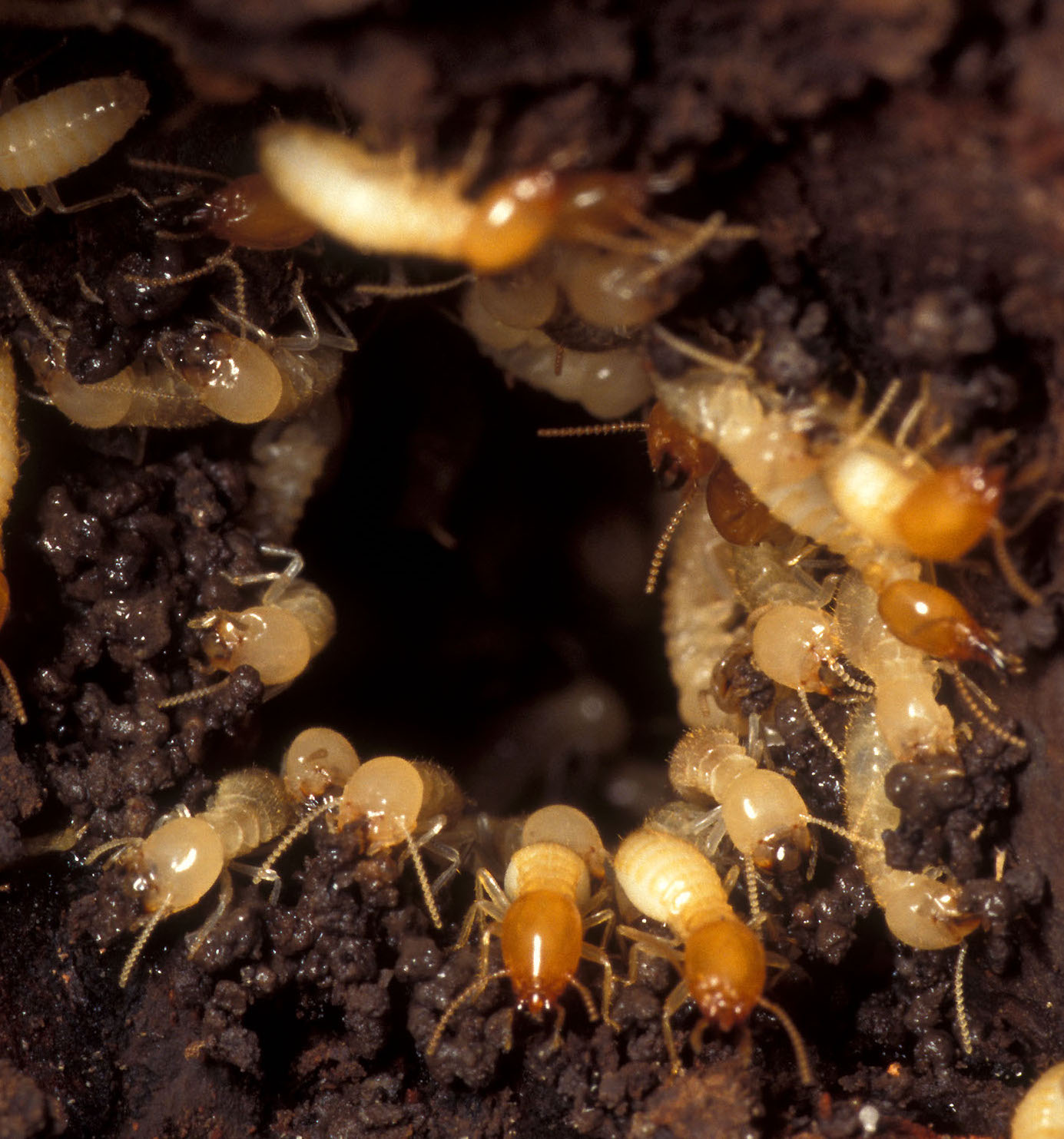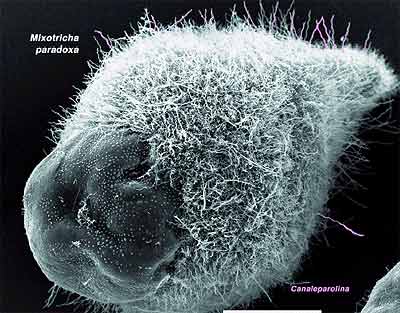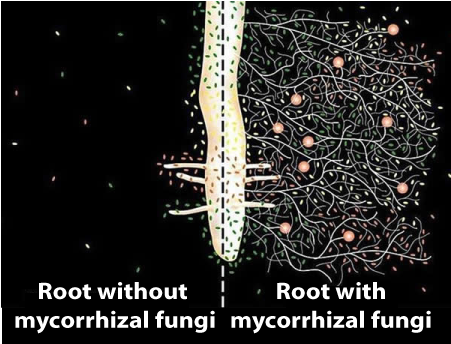Community Ecology Student Learning guide (link opens a new tab)
1. Introducing community ecology: the redwood forest
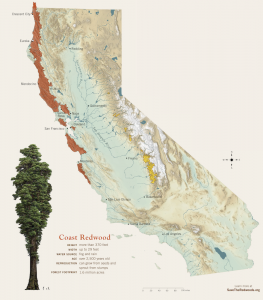
I live in Berkeley, California, which is on the east side of San Francisco Bay. Berkeley is in the fog belt: almost every evening, cold, moisture-laden air blows in from the Pacific Ocean toward the East Bay hills. Because of the fog, and because we’re close to the Pacific Ocean, temperatures are moderate all year round. It almost never snows, and summer temperatures rarely rise above 90° F (32° C). Every year, there’s a seasonal drought that lasts from about May through October. It rains in the winter, but not a lot: about 26 inches/per year.
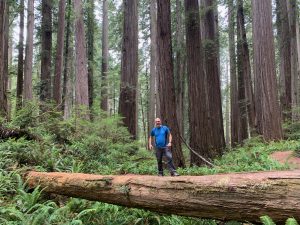
This weather pattern puts my city close to the southern tip of the Coast Redwood forest, a habitat that extends about 500 miles north up to the Oregon border. In northernmost California, some forests were never logged, with 1000-year-old trees that can be 300 feet (100 meters) tall: the tallest trees on Earth.
The redwood forest makes up a biological community: a group of populations of different species that live together in the same habitat. The plants in this community include the redwoods themselves; other trees, like Douglas Firs and Western Hemlocks; shrubs like huckleberries and rhododendrons; ferns like sword ferns and leather ferns; and a variety of small plants that live on the forest floor. These plants are joined by banana slugs, pacific giant salamanders, black-tailed deer, and Roosevelt elk. If you were lucky enough to visit these forests you’d hear songbirds like black-capped chickadees and varied thrushes. If you were camping, you’d probably see raccoons and scrub jays around your campsite. You probably wouldn’t see the much rarer bobcats or black bears, but these predators are there, too.


The redwood forest is not only a community: it’s also a habitat. A habitat is where an organism lives. The trees create this habitat’s physical structure, and also partly determine its physical characteristics. The canopy of the trees captures moisture from the fog that rolls in at night, creating a fog drip that adds a few extra inches of precipitation during the summer drought. The trees shade the forest floor from direct sunlight. As a result, the temperature on the ground can be significantly lower than that in the canopy of the trees. The indirect light that filters through the trees still has enough energy to drive photosynthesis, and it powers the growth of the shrubs, ferns, and herbs that grow beneath the redwoods. However windy it might be on the nearby beach or up in the canopy, there’s rarely much wind on the forest floor.
Within this habitat, each species has its particular niche. A niche is a species’ way of making a living. Note that you can say “niche” in two ways: “nitch” (rhymes with “itch”) or “neesh” (which will make you sound French, and very sophisticated).
An organism’s niche includes the resources that it needs, and how it goes about obtaining those resources. A useful memory trick is to think of a species’ habitat as its address and its niche as its profession.
In this module on community ecology, we’ll look at
- the various ways species interact with one another, and how that shapes an organism’s niche;
- how these interactions structure the way that a community is organized;
- how communities change over time.
- how a community’s diversity can be measured.
[qwiz qrecord_id=”sciencemusicvideosmeister1961-Community_Ecology_Introduction”]
[h] Community Ecology: Introduction
[i]
[q] The way an organism makes its living is its ecological [hangman].
[c]IG5pY2hl[Qq]
[q] The interacting populations in one area make up a biological [hangman].
[c]IGNvbW11bml0eQ==[Qq]
[q] An organism’s [hangman] can be roughly described as where it makes its home. This is where an organism finds the things it needs to [hangman].
[c]IGhhYml0YXQ=[Qq]
[c]IHN1cnZpdmU=[Qq]
[/qwiz]
2. Species Interactions: An Overview
For an overview of the types of interactions that can occur between species within a community, let’s isolate interactions that occur only between pairs of species. For each type of interaction, we’ll discuss its effect on each species’ fitness (its probability of surviving and reproducing). We’ll also use a widely used notation system for characterizing these interactions. If the species benefits from the interaction (if the interaction increases fitness), we’ll designate that with a “+.” If the interaction decreases fitness, we’ll designate that with a “-.” If there’s no effect on fitness, then we’ll use a “0.”
Note that these interactions also vary by duration. Predation, for example, is a short-term interaction that lasts only for as long as it takes a predator to stalk, kill, and consume its prey. Other interactions can last for weeks, months, or years.
Many pairs of species are involved in long-term, extremely close interactions in which the members of these species’ lives are deeply intertwined. These very close, long-lasting relationships are symbiotic, a term that means “living with.” Note that outside of your biology course, “symbiosis” is sometimes defined as a mutually beneficial ( “+,+”) interaction. But that’s not correct within biology, where the meaning of symbiosis allows for these relationships to be negative, positive, or neutral.
2a. Competition
On the African savannah cheetahs and lions often prey on the same herbivore species, such as zebras, antelopes, etc. That makes these carnivores competitors. Hummingbirds compete with butterflies for access to nectar in flowers. Because competition reduces resource availability for both competing species, it’s a “-, -” interaction. We’ll talk much more about the ecological and evolutionary consequences of competition below.
2b. Predation

Predation occurs when one animal kills and consumes another. Lions prey on zebras. Wolves prey on elk (and mice). Polar bears prey on seals. Dolphins prey on fish. Certain bats prey on insects.
Predation is a “+, -” interaction (plus for the predator, minus for the prey).
2c. Herbivory
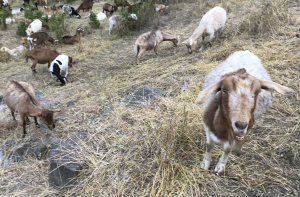
Herbivory occurs when animals (herbivores) eat plants. Unlike predation, the plant usually survives this encounter (but not always). The relationship is a “+,-” one: plus for the herbivore, minus for the plant.
2d. Mutualism
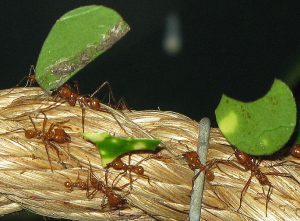
A symbiotic relationship that increases the fitness of both species is known as mutualism, and it’s notated as a “+, +” interaction. An example of mutualism involves any of the 47 species of leaf-cutter ants, which have evolved a symbiotic, mutualistic relationship with various fungi. The ants cut leaves off of plants and bring them to underground chambers. The leaves are fed to a fungus, which converts the leaves into fungal tissue, which serves as the ants’ food. Essentially, the ants are fungus farmers. These fungi are as dependent upon the ants as the ants are upon the fungi.
Our relationship with the bacteria in our intestines is also mutualistic. Because these bacteria live inside our bodies, they’re considered to be endosymbionts. These bacteria make up our “gut flora.” We provide them with food. They, in turn, provide us with certain nutrients and vitamins (vitamins B and K), aid digestion, and support our immune systems. Note, however, that we can also ingest parasitic microorganisms that can cause a host of diseases (discussed below).
Ruminants are a group of mammals that includes cows, goats, sheep, deer, camels, antelopes, and others, for a total of 250 species. These animals also have a mutualistic relationship with their endosymbiotic gut bacteria. In ruminants, gut bacteria break down the otherwise indigestible polysaccharide cellulose into glucose, which can then be absorbed into the bloodstream for energy. That’s why cows and other ruminants can thrive off a diet of grass, leaves, and so on. The bacteria benefit, receiving a constant stream of well-chewed food. The ruminants benefit by receiving chemical energy as their symbiotic bacteria convert cellulose to glucose.
|
|
In the insect world, termites have evolved mutualistic relationships with endosymbiotic microorganisms in their guts, enabling them to digest wood. That’s bad for termite-infested houses, but it’s a key part of the process of decomposition, which is required for nutrient cycling in ecosystems.
In the case of termites, the specific mutualist varies depending on the species. My favorite, however, is the mutualistic endosymbiont Mixotricha paradoxica. Mixotricha contains its own mutualistic endosymbionts: up to four distinct species of bacteria that live in or on Mixotricha. These bacteria play a variety of roles. Some aid its digestion of wood. Others enable it to propel itself through the termite’s guts.
For the species that harbor them, Mixotricha is essential to survival: termites without Mixotricha would starve. Juvenile termites acquire their own Mixotricha by ingesting Mixotricha in the feces of adult termites. Click here to learn about this in a short article and video in the Atlantic by noted science writer Ed Yong.

Here are three more important examples of mutualism to know about. Lichens are a mutualistic partnership between an alga (singular of “algae”) that lives within a fungus. In this “+, +” relationship, the photosynthetic algae provide the fungus with food. The fungus provides the algae with a place to live and essential nutrients.
|
|
Mycorrhizal fungi are fungi that have a symbiotic relationship with plant roots. The mycorrhizal fungi receive food from the plants; the plants receive nutrients and additional water from the fungi. Plants deprived of these symbionts (for example, by application of fungicides) grow significantly less.
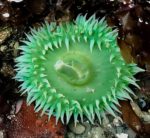
Returning to the animal kingdom, both sea anemones and corals have mutualistic relationships with algae that they harbor within their tissues. The algae get a safe place to live and receive micronutrients from their hosts. In return, the algae secrete glucose, which provides calories to their hosts.
2e. Parasitism
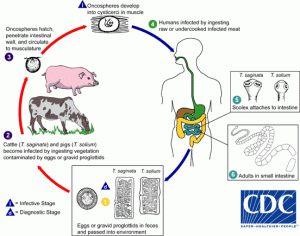
Parasitism occurs when one type of organism lives in or on another one — a host — in a way that causes benefit to the parasite and harm to the host. Depending on the life cycles of the interacting organisms, these symbiotic interactions can last for long periods. In humans, for example, parasitic infections — if not treated — can last for a lifetime.
An example of a parasite is the tapeworm. The lifecycle of this organism involves two hosts. In its human host, the tapeworm is an intestinal parasite. It uses suckers and barbs to hang onto the intestinal wall of a human host, absorbing pre-digested food from its host’s intestines. As it matures, the tapeworm releases sacs of eggs, which leave the body in the host’s feces.
In areas where people lack modern sewage and sanitation technology (and during most of human history), untreated feces can contaminate the soil or bodies of water. If tapeworm eggs from human feces are ingested by a pig or a cow (the second host), they’ll hatch within the pig’s or cow’s intestines. Next, the eggs develop into larvae that enter the circulatory system and migrate throughout the body, where they embed themselves into various tissues, including muscle tissue. Within these tissues, the larvae surround themselves with a protective covering, forming a cyst. If people eat the infected pig or cow without fully cooking the meat, these cysts can survive passage through the mouth and stomach. Once they get to the intestine, the larvae emerge from the cysts and grow into adult tapeworms inside the human’s intestines. Note that this parasitic relationship between tapeworms and humans relies on a predatory relationship between humans and pigs or cows.
Parasites come in all sizes. A single tapeworm can stretch the entire length of the intestine of its host. In humans, that means that a tapeworm can be several meters long. But parasites can be as small as a single cell. A single-celled eukaryotic parasite causes malaria, which infects hundreds of millions of people each year. Many bacteria have parasitic niches, including bacteria that cause diseases like cholera, diphtheria, leprosy, and bacterial pneumonia. Viruses are even smaller. Viruses, like SARS-CoV-2, HIV, measles, and influenza are nano-parasites that work on the cellular level, taking over individual cells and turning them into virus factories.
Parasitic relationships are represented as “+, -” (“plus” for the parasite, “minus” for the host). These parasitic lifestyles might seem bizarre or unusual. In fact, as science writer Carl Zimmer explains in his book Parasite Rex (the link takes you to a review on Wikipedia) there are more species of parasitic animals than there are of free-living ones. In other words, the most common animal niche is being a parasite.
2f. Parasitoidism
Parasitoidism is a variation of parasitism. Unlike long-term parasitic relationships, parasitoids feed on a living host, which eventually kills the host. Ten percent of insect species have parasitoid life cycles.

Here’s an unbelievable example. Parasitoid wasps within the family Ichneumonidae inject their eggs into the living body of the larvae of moths or other insects (the larvae of a moth or a butterfly are commonly known as “caterpillars,” and we’ll use that as our example). Within the body of the caterpillar, the wasp eggs develop into wasp larvae which absorb nutrients from the caterpillar’s body fluids. The wasp larvae, once mature, either create a cocoon inside the caterpillar’s body, or eat their way out, and then create their cocoon.
What keeps the caterpillar’s immune system from attacking these invaders? When the wasp injects her eggs into the caterpillar, she also injects a virus that suppresses the caterpillar’s immune system. The genes for the virus are a part of the wasp’s genome. When the wasp lays her eggs, these genes are expressed, forming the viral particles that the wasp can inject, along with her eggs, into her victim. If that isn’t amazing enough, the virus also reprograms the caterpillar’s behavior, causing the caterpillar to protect and defend the larvae (watch the video below to see more).
Based on phylogenetic studies, the roots of this mutualistic relationship between the virus and the wasp run very deep, possibly originating as long as 70 million years ago.
Watch this 5-minute video from National Geographic.
2g. Amensalism
As herds of cattle graze on grasslands, they trample a variety of insects underfoot. The cattle are unharmed as the insects are killed. That’s amensalism: a “0, -” interaction. On a much smaller scale, the mold Penicillium secretes penicillin, an antibiotic that inhibits bacterial growth. The penicillium is unaffected, but the bacteria are killed: a “0, -” interaction.
2h. Commensalism
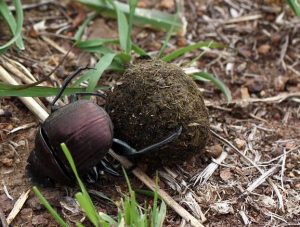
A commensal relationship is one in which one species benefits and the other is unaffected. Dung beetles eat cattle dung. This is of obvious benefit to the beetles but has little if any effect on cattle. It’s a “0, +” interaction.
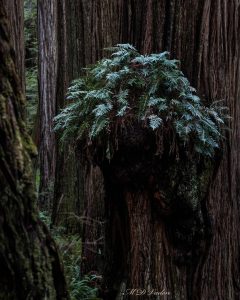
Epiphytes are plants that grow on other plants. In the redwood forest, leather ferns grow on the trunks of redwood trees. The tree is unharmed, and the fern gets to avoid predation from herbivores. Again, a “0, +” interaction.
3. Species Interactions: Checking Understanding
[qwiz style=”width: 650px !important; min-height: 400px !important;” qrecord_id=”sciencemusicvideosmeister1961-Species Interactions: Checking Understanding”]
[h] Species Interactions
[i]
[q labels = “top”]
| Interaction | Definition/Description | Effect on Species 1 | Effect on Species 2 |
| Competition | Two species require the same ____________ | _____ | _____ |
| ______________ | Species 1 is unaffected. Species 2 is harmed. | _____ | _____ |
| ______________ | Both species _________ from the interaction | + | + |
| ________________ | Species 1 benefits; species 2 is unaffected | _____ | _____ |
| Predation | Animal species 1 _______________ animal species 2 | + | – |
| ______________ | An animal consumes a plant | + | – |
| ______________ | A long-term relationship in which species 1 lives in or on species 2, which is the _________. Species 2 is harmed. | _____ | _____ |
| ______________ | Species 1 lays its eggs in or on the eggs or ________ of species 2. Individuals in species 2 ______ | + | – |
[l]amensalism
[f*] Correct!
[fx] No, that’s not correct. Please try again.
[l]benefit
[f*] Excellent!
[fx] No, that’s not correct. Please try again.
[l]commensalism
[f*] Good!
[fx] No, that’s not correct. Please try again.
[l]kills and eats
[f*] Good!
[fx] No, that’s not correct. Please try again.
[l]die
[f*] Great!
[fx] No, that’s not correct. Please try again.
[l]herbivory
[f*] Excellent!
[fx] No. Please try again.
[l]host
[f*] Good!
[fx] No, that’s not correct. Please try again.
[l]larvae
[f*] Good!
[fx] No, that’s not correct. Please try again.
[l]mutualism
[f*] Good!
[fx] No, that’s not correct. Please try again.
[l]parasitism
[f*] Great!
[fx] No, that’s not correct. Please try again.
[l]Parasitoidism
[f*] Correct!
[fx] No, that’s not correct. Please try again.
[l]resource
[f*] Great!
[fx] No. Please try again.
[l]–
[f*] Good!
[fx] No. Please try again.
[l]+
[f*] Great!
[fx] No, that’s not correct. Please try again.
[l]0
[f*] Excellent!
[fx] No, that’s not correct. Please try again.
[q] In many cultures, humans keep dogs as pets. Some dogs protect their human owners. This relationship is a [hangman] one. In other cultures, humans eat dogs. That relationship is best described as [hangman].
[c]IG11dHVhbGlzdGlj[Qq]
[f]IEdyZWF0IQ==[Qq]
[c]IHByZWRhdGlvbg==[Qq]
[f]IEdyZWF0IQ==[Qq]
[q] The giant green sea anemone hosts algae that live safely within the anemone’s body. The algae secrete sugars that the anemone can use for energy. This is an example of [hangman]. Because the relationship is so close, it can also be described as [hangman].
[c]IG11dHVhbGlzbQ==[Qq]
[f]IEdyZWF0IQ==[Qq]
[c]IHN5bWJpb3RpYw==[Qq]
[f]IEdyZWF0IQ==[Qq]
[q] When weeds grow among your tomato plants, the tomatoes don’t grow as well. This is an example of [hangman].
[c]IGNvbXBldGl0aW9u[Qq]
[f]IEdvb2Qh[Qq]
[q] When deer eat shrubs, it’s an example of [hangman].
[c]IGhlcmJpdm9yeQ==[Qq]
[f]IEdyZWF0IQ==[Qq]
[q]
[c]IG11dHVhbGlzbQ==[Qq]
[f]IEdyZWF0IQ==[Qq]
[c]IGNvbW1lbnNhbGlzbQ==[Qq]
[f]IEdvb2Qh[Qq]
[c]IHBhcmFzaXRpc20=[Qq]
[f]IEdyZWF0IQ==[Qq]
[q] The mitochondria in our cells take pyruvic acid and use its chemical energy to create ATP. To get ATP, eukaryotic cells feed their mitochondria with pyruvic acid. This ancient relationship is an example of [hangman].
[c]IG11dHVhbGlzbQ==[Qq]
[f]IEV4Y2VsbGVudCE=[Qq]
[/qwiz]
4. Competition: A closer look
Competition occurs when two (or more) species seek to exploit the same environmental resources. In other words, competition occurs when two (or more) species find themselves in the same ecological niche.
To start to understand what some of the consequences of competition are, it helps to think in terms of economics, rather than ecology.
Imagine this scenario. Kim and Maya owned a cafe on the corner of Main Street and First Avenue. From 1998 to 2016, their business thrived. In 2016 a new Starbucks set up shop on the corner of Main Street and Third Avenue. By 2019, Kim and Maya were out of business. They couldn’t compete. In the economic niche of “coffee shops,” their town could only support one business. The superior competitor — Starbucks — won out.
Now, consider these three restaurants. You often find them in the same city, within a few blocks of one another.

Economically speaking, these three restaurants are also in the same economic niche: they all sell a similar product (hamburgers) to a similar segment of the restaurant market (fast food). How, then, do they continue to coexist? It’s because they’ve slightly differentiated themselves from one another. Through marketing, pricing, and product line, they’ve tried to carve out their own sub-segment of the fast food market. Note that co-existence is not any of these companies’ goals: they’d just as soon put their competition out of business (and sell more hamburgers). But as each company moves to gain a competitive advantage, the other companies adapt, gaining advantages of their own.
4a. Gause and Competitive Exclusion
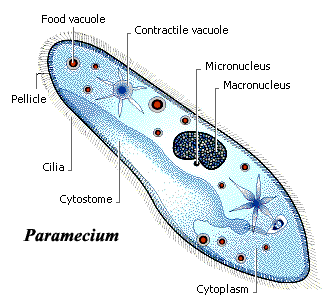
Parallel processes occur between competing species. This is captured by Gause’s competitive exclusion principle, named for Russian evolutionary biologist Georgy Gause (1910 – 1986). Early in his career, Gause performed a series of experiments about competition with various species of the single-celled ciliated eukaryote Paramecium (shown at right).
Because they’re so small, entire populations of paramecia can be grown in a test tube. In the interactive reading below, the conditions are slightly simplified to better communicate the key concepts.
[qwiz style=”width: 700px !important; min-height: 500px !important;” qrecord_id=”sciencemusicvideosmeister1961-Competitive Exclusion, Interactive Reading”]
[h]Competitive Exclusion
[i]
[q]In one experiment, Gause took two different species of Paramecia. Both of these species had a similar ecological niche. In their natural environments, each species fed on debris on the bottom of a pond or a stream. In the artificial environment that Gause set up, that niche was eating food (yeast) in the bottom of a test tube.
When each species was kept in its own test tube, it was able to survive and increase in numbers to what was the carrying capacity of the test tube. Study the diagram and graphs below, and click “next” when you’re ready.
[q]In the next phase of the experiment, Gause transferred both Paramecia populations into the same test tube. Note that in Gause’s experiment, there wasn’t time for the species to evolve into a new ecological niche. All that they could do was compete for the resources. Which of the graphs below shows the most likely outcome?
[textentry single_char=”true”]
[c]ID I=[Qq]
[f]IFRoYXQmIzgyMTc7cyByaWdodC4gVGhlIHR3byBzcGVjaWVzIHdlcmUgaW4gdGhlIHNhbWUgZWNvbG9naWNhbCBuaWNoZS4gSW4gdGhpcyBjYXNlLCBvbmUgc3BlY2llcyAoQSkgaGFkIHNvbWUgYWR2YW50YWdlIHRoYXQgZW5hYmxlZCBpdCB0byBvdXRjb21wZXRlIHNwZWNpZXMgQi4=[Qq]
[c]IEVudGVyIHdvcmQ=[Qq]
[c]ICo=[Qq]
[f]IE5vLiBSZW1lbWJlciB0aGF0IGJvdGggb2YgdGhlc2Ugc3BlY2llcyBzaGFyZSB0aGUgc2FtZSBlY29sb2dpY2FsIG5pY2hlLCB3aGljaCBtZWFucyB0aGF0IHRoZXkmIzgyMTc7cmUgY29tcGV0aW5nIGZvciB0aGUgc2FtZSByZXNvdXJjZXMuIFdoYXQmIzgyMTc7cyB0aGUgbW9zdCBsaWtlbHkgb3V0Y29tZSBpbiB0aGlzIGNpcmN1bXN0YW5jZT8=[Qq]
[q labels = “top”]Let’s think a bit about what happened in this first round of Gause’s experiment.
Species A and B both shared the same ecological ___________. Another way to say that is that they consumed the same ____________ within their environments. Because of some unknown _____________, species A was able to _______________ species B, forcing species B into ____________
[l]advantage
[fx] No. Please try again.
[f*] Correct!
[l]extinction
[fx] No, that’s not correct. Please try again.
[f*] Great!
[l]niche
[fx] No. Please try again.
[f*] Correct!
[l]outcompete
[fx] No. Please try again.
[f*] Good!
[l]resources
[fx] No. Please try again.
[f*] Good!
[q labels = “top”]Fill in the blanks for Gause’s conclusion: Two species that require the same environmental _____________ cannot occupy the same ecological ________. This idea has come to be known as Gause’s _____________ ____________ principle
[l]niche
[fx] No. Please try again.
[f*] Good!
[l]competitive
[fx] No, that’s not correct. Please try again.
[f*] Good!
[l]resources
[fx] No. Please try again.
[f*] Good!
[l]exclusion
[fx] No, that’s not correct. Please try again.
[f*] Excellent!
[q] Here’s another experiment performed by Gause. He combined Species A (a bottom dweller) with Species C (which prefers to forage closer to the surface). Which graph represents what happened when these two species were combined in the same test tube?
[textentry single_char=”true”]
[c]ID E=[Qq]
[f]IFRoYXQmIzgyMTc7cyByaWdodC4gRWFjaCBzcGVjaWVzIGhhcyBhIGRpZmZlcmVudCBlY29sb2dpY2FsIG5pY2hlLiBBcyBhIHJlc3VsdCwgd2hlbiB0aGV5JiM4MjE3O3JlIGNvbWJpbmVkIGludG8gdGhlIHNhbWUgdGVzdCB0dWJlLCB0aGV5JiM4MjE3O2xsIGJlIGFibGUgdG8gY29leGlzdC4gU3BlY2llcyBBIHdpbGwgYmUgYWJsZSB0byBmaW5kIGl0cyBmb29kIG9uIHRoZSBib3R0b20gb2YgdGhlIHR1YmUuIFNwZWNpZXMgQyB3aWxsIGZpbmQgaXRzIGZvb2QgY2xvc2VyIHRvIHRoZSBzdXJmYWNlLg==[Qq]
[c]IEVudGVyIHdvcmQ=[Qq]
[c]ICo=[Qq]
[f]IE5vLiBSZW1lbWJlciB0aGF0IHRoZXNlIHNwZWNpZXMgYXJlIGluIGRpZmZlcmVudCBlY29sb2dpY2FsIG5pY2hlcywgd2l0aCBBIGZlZWRpbmcgb24gdGhlIGJvdHRvbSBhbmQgQyBmZWVkaW5nIHRvd2FyZCB0aGUgc3VyZmFjZS4gVGhpbmsgYWJvdXQgcmVzdGF1cmFudHMuIEFzc3VtZSB0aGF0IHlvdXIgdG93biBoYXMgZW5vdWdoIGN1c3RvbWVycy4gVGhlcmUmIzgyMTc7cyBhIHN1Y2Nlc3NmdWwgYnVyZ2VyIGpvaW50IG9uIE1haW4gU3RyZWV0LiBBIE1leGljYW4gcmVzdGF1cmFudCBvcGVucyB1cCB0d28gYmxvY2tzIGF3YXkuIFdoYXQgd291bGQgaGFwcGVuPw==[Qq]
[q]Let’s review this second experiment. Species A and C have different ecological [hangman]. As a result, when combined into the same test tube, there’s relatively little [hangman] between them. This enables both of these species to [hangman] within the same environment.
[c]bmljaGVz[Qq]
[c]Y29tcGV0aXRpb24=[Qq]
[c]Y29leGlzdA==[Qq]
[/qwiz]
4b. Resource Partitioning and Character Displacement
In Gause’s second experiment, we see how two species can coexist in the same environment if they exploit distinct parts or segments of an environment’s resources. Dividing up resources within an environment is called niche partitioning (sometimes also referred to as “resource partitioning”).
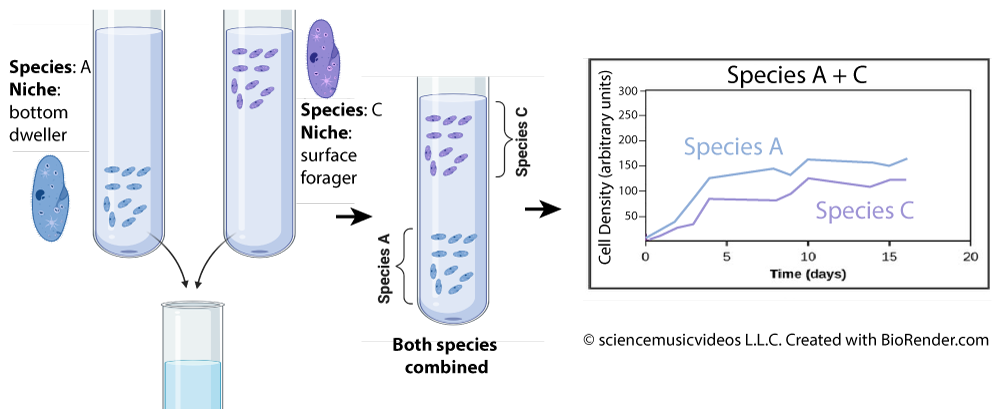
Here’s a cartoon example of niche partitioning, drawn by the fabulous BioNinja.

Here we have three bird species coexisting on the same tree. How? By dividing up the resource as shown.
Niche partitioning goes hand in hand with character displacement. As the ecological niches of competing species diverge from one another over evolutionary time, each species will develop distinct adaptations.
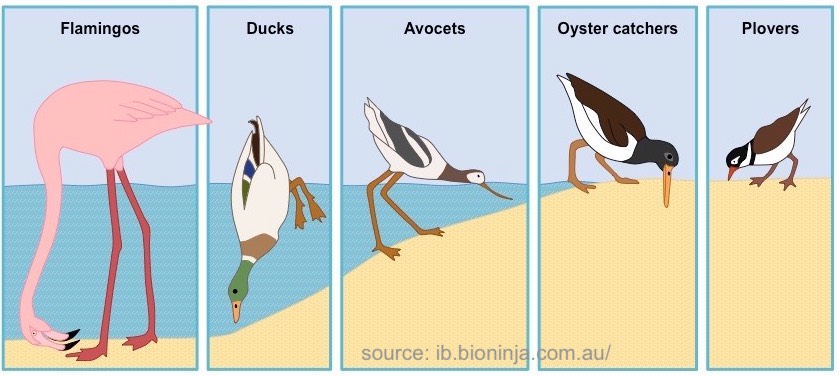
You can see character displacement in this diagram of South Atlantic shorebirds.
All of these birds are found on the sandy shore. Each is exploiting a different part of the overall resource: crustaceans and other animals that live where the ocean meets the sand. To harvest that segment of the resource, each species has evolved different adaptations enabling them to outcompete their competitors in their specific niche. These adaptations include, most obviously, leg length and beak shape.
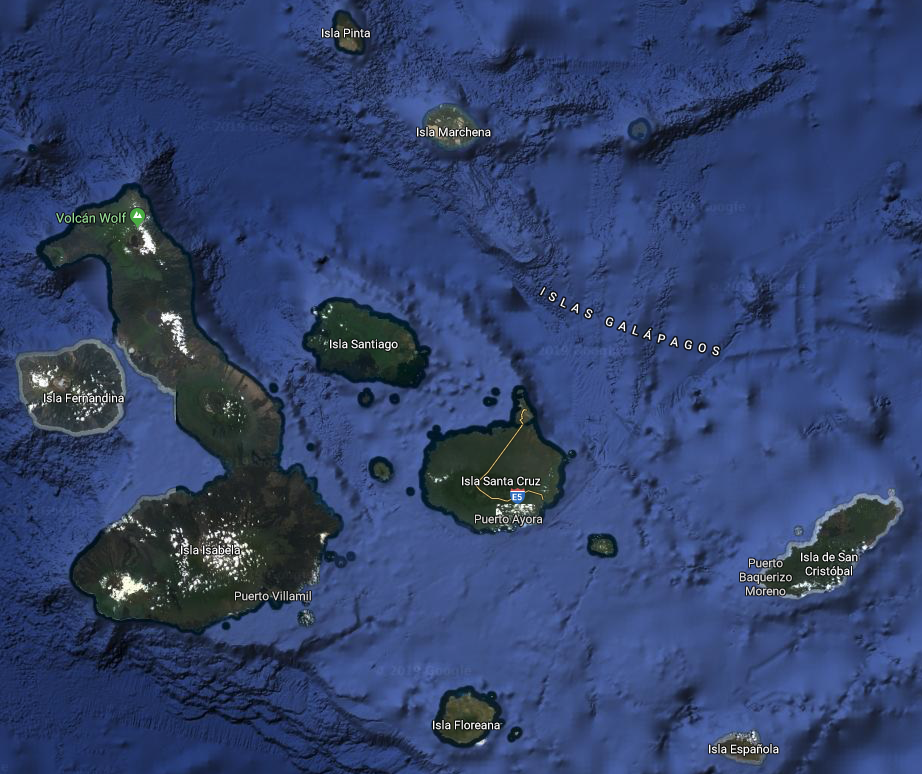
Here’s a more subtle example of character displacement found in the finches that live on the Galapagos Islands, a group of volcanic islands located about 1000 km (600 miles) off the coast of Ecuador. The Galapagos have become biologically famous because of their influence on Charles Darwin, who visited them in 1825 when serving as a naturalist on the HMS Beagle. To review the process of adaptive radiation that gave rise to the dozen or so species of finches found on the Galapagos, click here. To review Galapagos finch phylogeny, click here (both links open in new tabs)
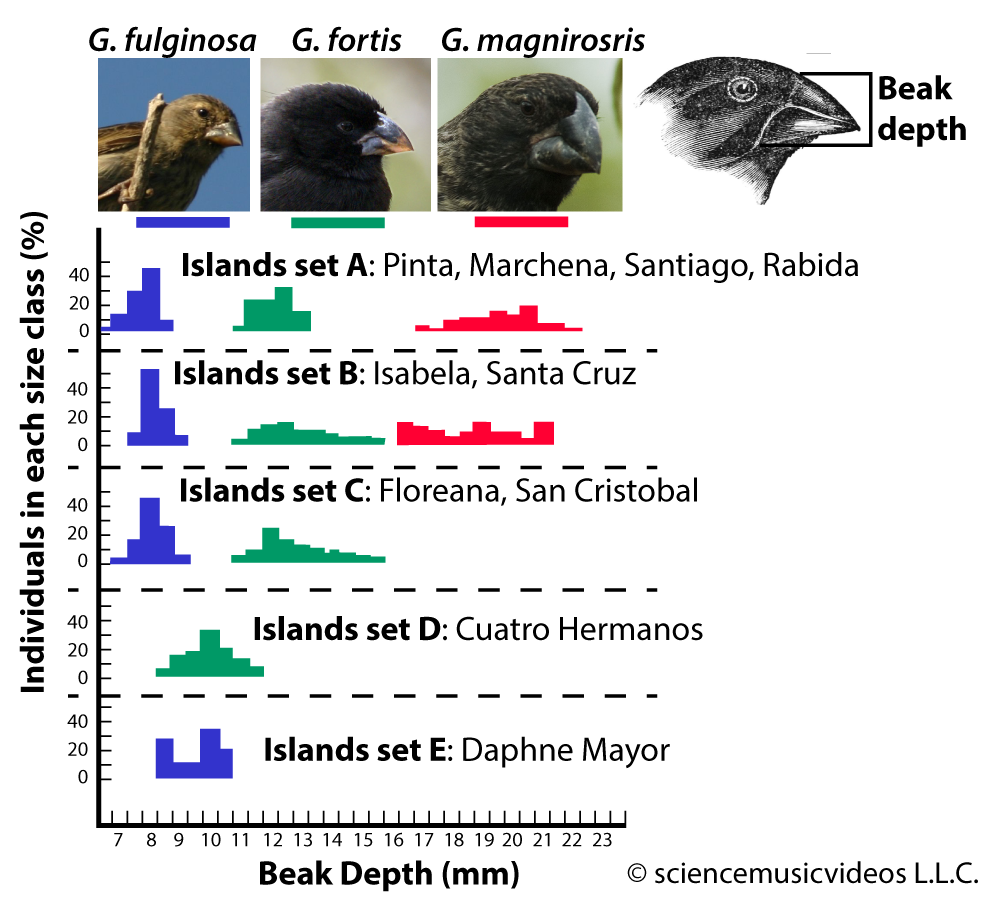
The diagram at right shows beak depth in three species of finches: the large ground finch (Geospiza magnirostris), the medium ground finch (Geospiza fortis), and the small ground finch (Geospiza fulginosa).
On Islands set A and B, all three birds coexist on the same islands. Note how in this situation, there’s no overlap in beak depth between any of the three species. Why? Because interspecific competition between each species creates selective pressure for niche partitioning. To dominate in its specific niche, each bird becomes adapted to eat different types of food. The large beak of G. magnirostris enables it to dominate the large seed niche. The small beak of G. fulginosa makes it well adapted for eating small seeds, and for picking parasites off of Galapagos tortoises and iguanas. That leaves an intermediate niche (medium-sized seeds, flowers, bugs, and young leaves) for G. fortis.
On island set C, G magnirostris is absent. However, interspecific competition between G. fulginosa and G. fortis keeps their beak size from overlapping.
Note what happens, however, in islands D and E. On each of these islands, only one species of finch is present. Without competitive pressure from any other species, the beak size of G. fortis becomes smaller. That smaller size enables G. fortis to exploit food that was previously only available to G. fulginosa. Similarly, when isolated on its own island, the beak size of G. fulginosa is selected for a larger size. The key thing to note is that without competitive pressure on island sets D and E, character displacement decreases.
4c. Realized Niche v. Fundamental Niche
Another way to think of niche partitioning is as follows: competition forces the competing species to narrow their ecological niches. This was demonstrated in a famous ecological experiment, this time by American ecologist Joseph Connell.
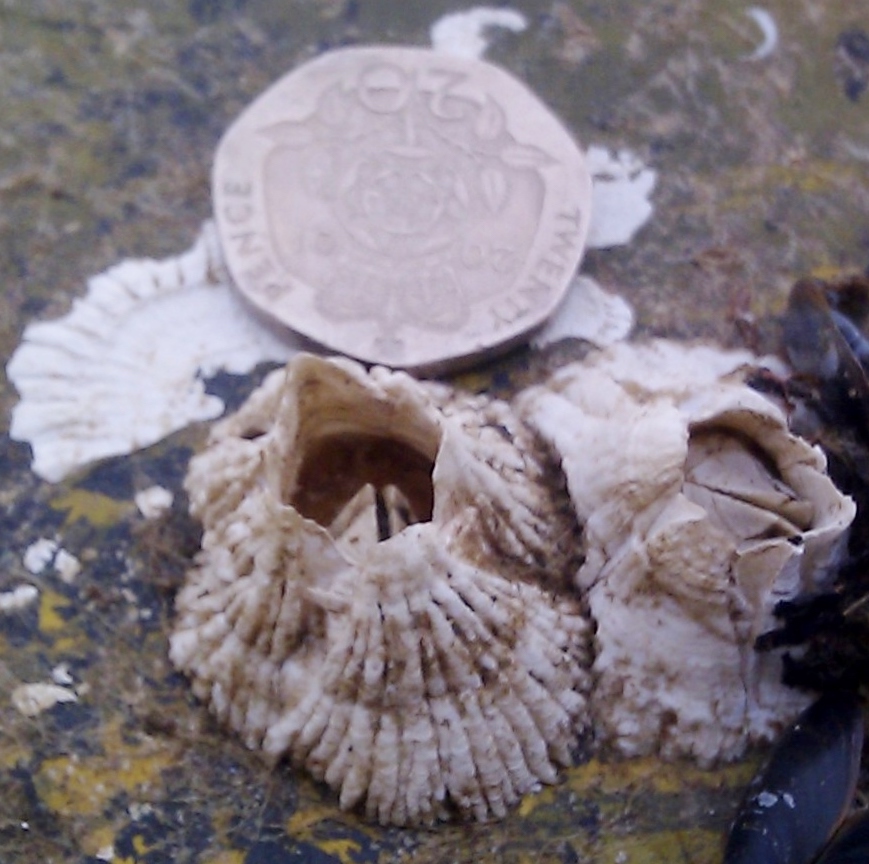
Connell’s study involved two species of barnacles that live on the rocky shores of Scotland. Barnacles are crustaceans, a clade that includes crayfish and lobsters. If you visit the rocky shore, you’ll find them in what’s called the intertidal zone, the area between the high tide line and the low tide line.
The intertidal zone is a difficult environment. The organisms that live there are primarily sea creatures, getting their food and oxygen from seawater when they’re submerged by the tide. But they also need to be able to survive hours of exposure to air and sunlight during low tide.
A close-up photograph of two barnacles is shown on the right.
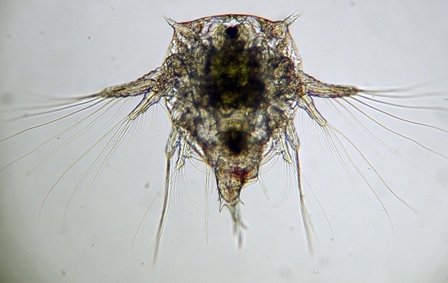
Early in their lifecycle, barnacles have a free-living larval form that swims around until it lands on the rocks in the intertidal zone.
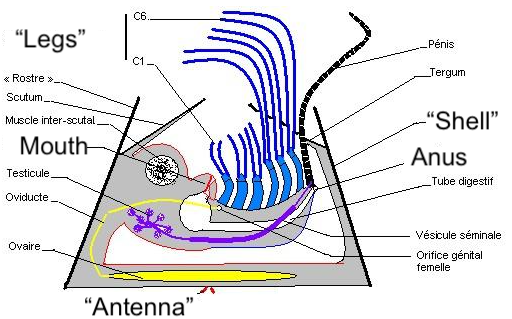
Once on the rocks, the larvae use a specialized gland on their head to secrete glue that permanently attaches them to the spot where they’ve landed. Once attached, they undergo a transformation that rivals the metamorphosis of a caterpillar into a butterfly. The anatomy of the adult form is shown on the right. The legs are homologous to legs in crabs and crayfish, but they’ve evolved into feathery appendages that grab food particles from ocean water and toss them into the barnacle’s mouth. The “shell” is a modified exoskeleton. Note that these animals are hermaphroditic (both male and female).
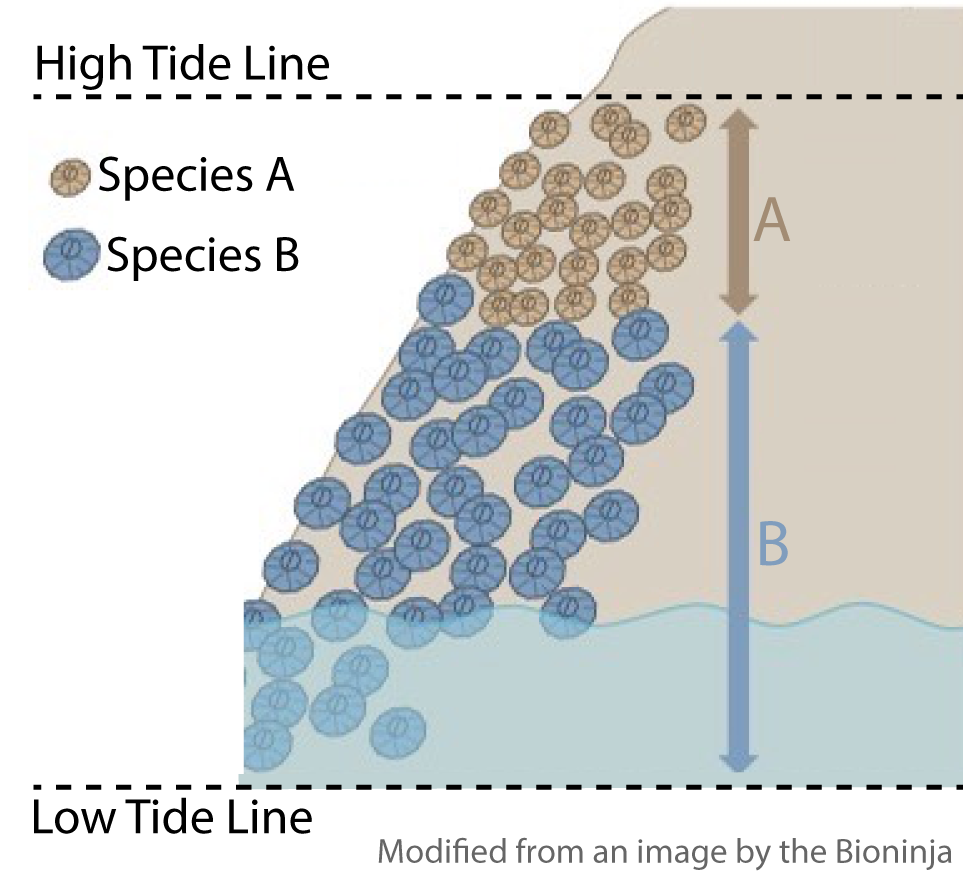
Connell started by noting the distribution of two species that encrusted the rocks in the intertidal zone. The range of species A was limited to the zone nearest the high tide line (indicated by the line “A”). Species “B” was found lower down, in the range indicated by line “B.” Connell also noted that the larvae of each species could land anywhere on the rocks. So what factors limited each species to its particular area?
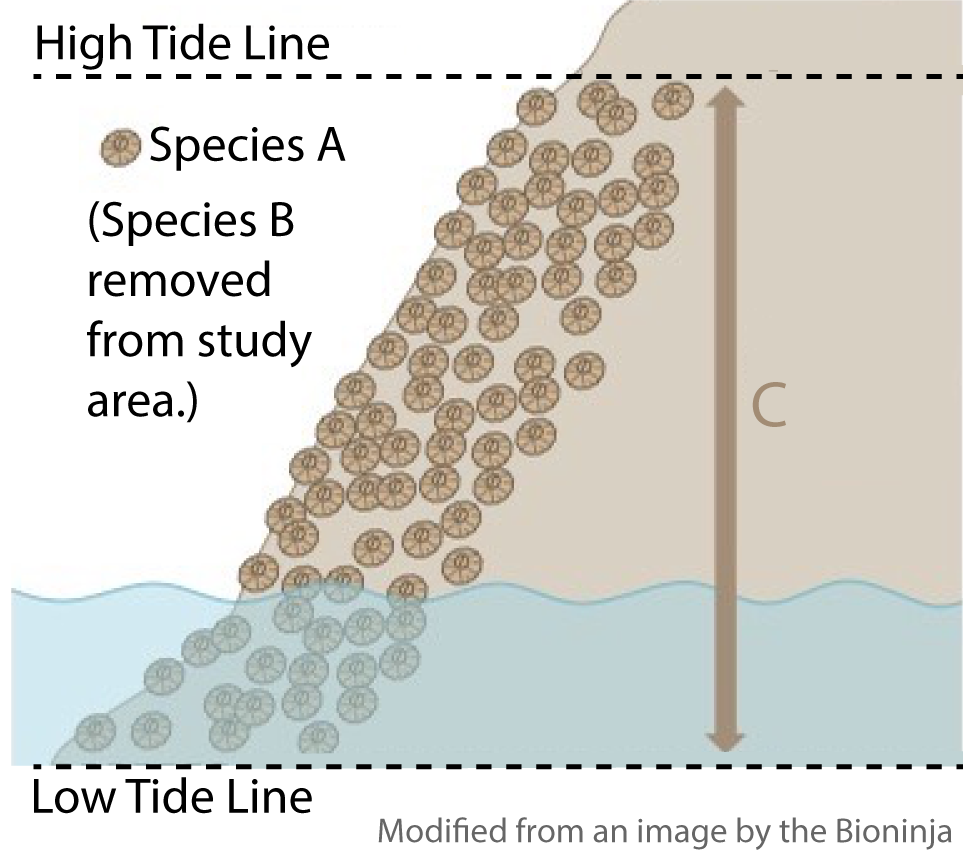
Connell’s next move was to scrape species B off the rocks. Over the ensuing period of the study, species A was able to successfully colonize the area that had formerly been inhabited by species B. Species A’s new range is represented by line “C.”
Connell concluded that competition from species B was what was limiting species A from living lower down in the intertidal zone. Could competition also be the explanation for why species B didn’t live higher up in the rocks? Connell tested this hypothesis by removing species A from the rocks and watching what happened over the subsequent months of the study.
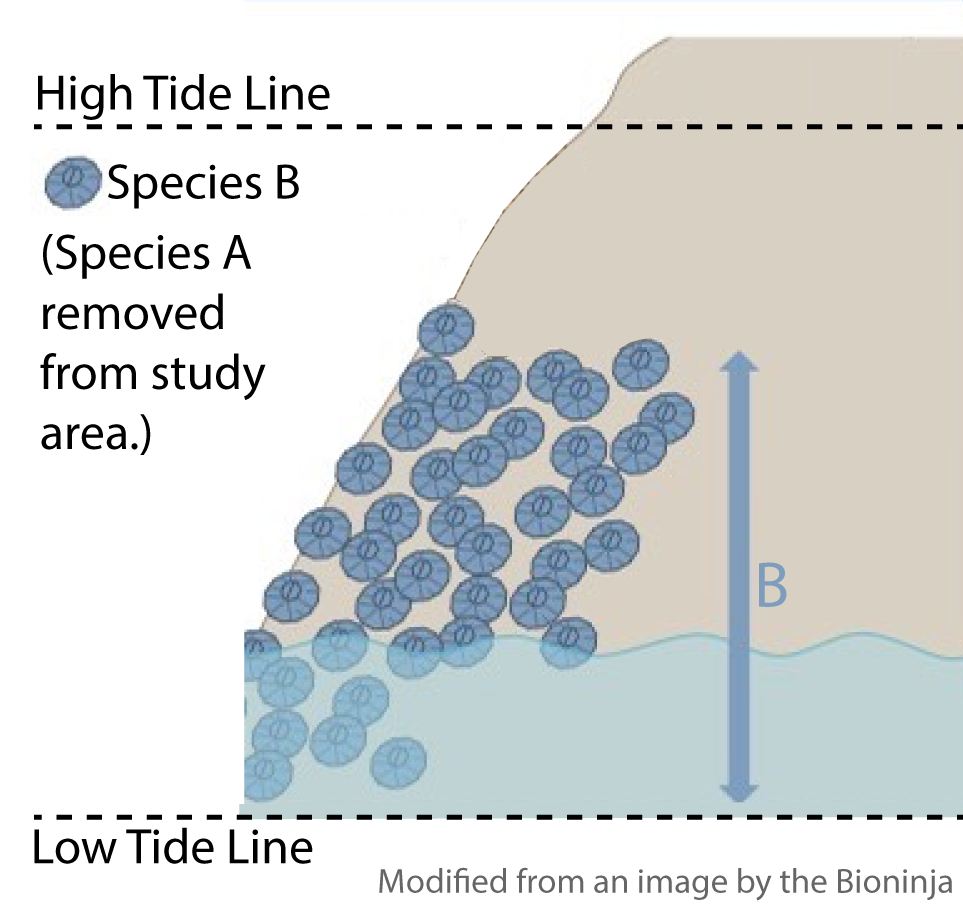
Here’s the result. Removal of species A did not change the range of species B. Connell concluded that species B’s failure to colonize the highest part of the intertidal zone was not due to competition from species A. Rather, it was caused by the inability of species B to survive exposure to air and sun (and the drying effects of both). In other words, abiotic (non-living) factors were limiting the range of species B. By contrast, a biotic factor —specifically, competition —was what was limiting the range of species A.
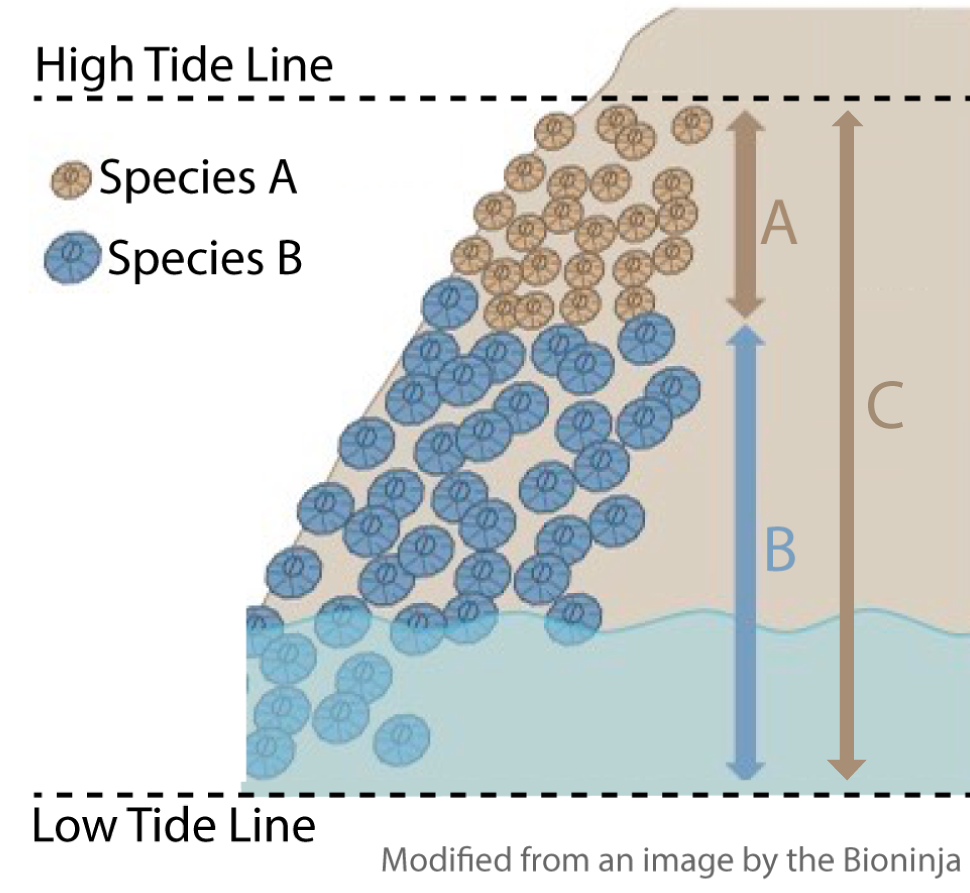
Here’s an image that pulls all of this together, and which allows us to introduce a new concept. “A” and “B” are realized niches. They represent the range of resources that each species actually exploits in its natural environment. “C” is the fundamental niche of species A: it’s the possible range of resources that species A could exploit, if it weren’t prevented from doing so by species B. Note that the difference between the realized niche and fundamental niche is solely about biotic factors, like competition. For species B, which can’t survive the exposure at the highest tide zone, the fundamental and the realized niches are the same.
Let’s pull our study of competition together with a quiz.
5. Quiz: Competition and its consequences.
[qwiz style=”width: 650px !important; min-height: 400px !important;” qrecord_id=”sciencemusicvideosmeister1961-Competition and its consequences”]
[h]Competition and its consequences
[i]
[q] In the diagram below, which letter indicates the fundamental niche of species A
[textentry single_char=”true”]
[c]IE M=
[f]RXhhY3RseS4gJiM4MjIwO0MmIzgyMjE7IGlzIHRoZSBmdW5kYW1lbnRhbCBuaWNoZSBvZiBzcGVjaWVzIEE=[Qq]
[c]IEVudGVyIHdvcmQ=[Qq]
[c]ICo=[Qq]
[f]IE5vLiBIZXJlJiM4MjE3O3MgYSBoaW50LiBUaGUgZnVuZGFtZW50YWwgbmljaGUgb2YgYSBzcGVjaWVzIGlzIHRoZSByYW5nZSBvZiByZXNvdXJjZXMgaXQgY291bGQgZXhwbG9pdCBpbiB0aGUgYWJzZW5jZSBvZiBjb21wZXRpdGlvbi4gV2hhdCBsZXR0ZXIgc2hvd3MgaG93IEEgZG9lcyB3aGVuIGl0cyBjb21wZXRpdG9yIChCKSBpcyByZW1vdmVkPw==[Qq]
[q] Which diagram (1, 2, or 3) shows the effect of abiotic factors limiting a species’ niche?
[textentry single_char=”true”]
[c]ID M=
[f]TmljZS4gJiM4MjIwOzMmIzgyMjE7IHNob3dzIGhvdyB0aGUgYWJzZW5jZSBvZiBzcGVjaWVzIEEgZG9lc24mIzgyMTc7dCBjaGFuZ2UgdGhlIGRpc3RyaWJ1dGlvbiBvZiBzcGVjaWVzIEIuIElmIGNvbXBldGl0aW9uIGlzbiYjODIxNzt0IGxpbWl0aW5nIEImIzgyMTc7cyBuaWNoZSwgdGhlbiBpdCYjODIxNztzIG1vc3QgbGlrZWx5IGFiaW90aWMgZmFjdG9ycyAoc3VjaCBhcyB0aGUgZHJ5aW5nIGFuZCBzdW5saWdodCBleHBlcmllbmNlZCBpbiB0aGUgdXBwZXIgcGFydCBvZiB0aGUgaW50ZXJ0aWRhbCB6b25lKS4=[Qq]
[c]IEVudGVyIHdvcmQ=[Qq]
[c]ICo=[Qq]
[f]IE5vLiBIZXJlJiM4MjE3O3MgYSBoaW50LiBOb3RlIHdoYXQgaGFwcGVucyB3aGVuIGVhY2ggc3BlY2llcyBpcyByZW1vdmVkLiBXaGljaCBkaWFncmFtIHNob3dzIGEgc2l0dWF0aW9uIHdoZXJlIGEgc3BlY2llcyYjODIxNzsgbmljaGUgaXNuJiM4MjE3O3QgYWZmZWN0ZWQgYnkgdGhlIHJlbW92YWwgb2YgYSBjb21wZXRpdG9yPw==[Qq]
[q multiple_choice=”true”] Which letter shows the realized niche of species A?
[textentry single_char=”true”]
[c]IG E=
[f]RXhjZWxsZW50LiBMZXR0ZXIgJiM4MjIwO2EmIzgyMjE7IHNob3dzIHRoZSByZWFsaXplZCBuaWNoZSBvZiBzcGVjaWVzIEE=[Qq]
[c]IGI=[Qq]
[f]Tm8uIFRoZSByZWFsaXplZCBuaWNoZSBzaG93cyB0aGUgYWN0dWFsIHJhbmdlIG9mIHJlc291cmNlcyB0aGF0IGEgc3BlY2llcyBjYW4gZXhwbG9pdC4gQ29tcGV0aXRpb24gY2F1c2VzIHRoZSByZWFsaXplZCBuaWNoZSB0byBiZSBuYXJyb3dlciB0aGFuIHRoZSByZWFsaXplZCBuaWNoZS4=[Qq]
[c]IGM=[Qq]
[f]IE5vLiBUaGUgcmVhbGl6ZWQgbmljaGUgc2hvd3MgdGhlIGFjdHVhbCByYW5nZSBvZiByZXNvdXJjZXMgdGhhdCBhIHNwZWNpZXMgY2FuIGV4cGxvaXQuIENvbXBldGl0aW9uIGNhdXNlcyB0aGUgcmVhbGl6ZWQgbmljaGUgdG8gYmUgbmFycm93ZXIgdGhhbiB0aGUgcmVhbGl6ZWQgbmljaGUu[Qq]
[q] In the diagram below, letter A represents the [hangman] niche of species A. Letter C represents species A’s [hangman] niche.
[c]cmVhbGl6ZWQ=[Qq]
[c]ZnVuZGFtZW50YWw=[Qq]
[q] Based on Connell’s experiment with species removal, you can conclude that [hangman] is what’s making species A’s realized niche [hangman] than its fundamental niche.
[c]Y29tcGV0aXRpb24=[Qq]
[c]bmFycm93ZXI=[Qq]
[q] Based on Connell’s experiment with species removal, you can conclude that the reason that species B can’t expand into the upper tide zone is not [hangman]. Rather, it’s probably [hangman] factors such as sunlight, heat, and resulting drying that are limiting the [hangman] of species B
[c]Y29tcGV0aXRpb24=[Qq]
[c]YWJpb3RpYw==[Qq]
[c]bmljaGU=[Qq]
[q]The phrase that best describes what’s happening in the diagram below is [hangman] [hangman].
[c]Y2hhcmFjdGVy[Qq]
[c]ZGlzcGxhY2VtZW50[Qq]
[q]The phrase that best describes what’s happening in the diagram below is [hangman] [hangman].
[c]bmljaGU=[Qq]
[c]cGFydGl0aW9uaW5n[Qq]
[q]In this diagram of shorebirds, one could say that the way that each species exploits prey from a different part of the shoreline is an example of [hangman] [hangman]. The unique adaptations that allow each species to dominate one type of food resource could be cited as an example of [hangman] [hangman]. And because of competition, one could conclude that each species’ [hangman] niche is narrower than its [hangman] niche.
[c]bmljaGU=[Qq]
[c]cGFydGl0aW9uaW5n[Qq]
[c]Y2hhcmFjdGVy[Qq]
[c]ZGlzcGxhY2VtZW50[Qq]
[c]cmVhbGl6ZWQ=[Qq]
[c]ZnVuZGFtZW50YWw=[Qq]
[q]The idea that no two species can co-exist in that same ecological niche is summed up by the principle of [hangman] [hangman].
[c]Y29tcGV0aXRpdmU=[Qq]
[c]ZXhjbHVzaW9u
Cg==W3Jlc3RhcnRd[Qq]
[/qwiz]
6. Predators, Prey, Parasites, and Evolutionary Arms Races

The rough-skinned newt, Taricha granulosa, lives in the Pacific Northwest. It can be found between Santa Cruz, California, north to Alaska. These newts secrete a neurotoxin called tetrodotoxin onto their skin. Tetrodotoxin is also found in Pufferfish, a Japanese seafood delicacy that can be fatal when improperly prepared.
Tetrodotoxin binds to sodium channels in nerve cell membranes in a way that makes nerve impulse transmission impossible. As a result, an animal that eats a newt (or improperly prepared pufferfish) can become paralyzed. Inactivation of the nerves that control breathing can lead to death by asphyxiation.

Newts, which range from 11 to 18 millimeters long from snout to tail, produce enough toxin to kill a human. In 1979, a 29-year-old man intentionally swallowed a newt (on a dare source). He died a few hours later.
The newt’s toxicity is the result of natural selection by the Northwest Garter Snake, which preys on newts. How can the snake consume such a toxic animal? Snakes survive ingesting newts because of an alteration to their sodium channels that prevents tetrodotoxin from binding. Studies have shown that areas where snakes have the highest level of resistance to the toxin are the areas with the highest level of newt toxicity. (see Gross, 2008, in PLOS Biology).
The toxicity of the newt and the toxin resistance of the garter snake are examples of the results of what’s called an evolutionary arms race. Here’s how it works.
Arms races

The “arm” in “arms race” refers to the term armament, which means military equipment. Arms races occur between competing nations, each of which perceives the other as a threat. A famous arms race took place during the Cold War between the United States and the Soviet Union (the former Communist state that is now Russia). Here’s a very brief sketch of what happened.
- In 1945, the United States used two atomic bombs to destroy the Japanese cities of Hiroshima and Nagasaki. This led Japan to surrender, ending World War II.
- The Soviet Union perceived the United States’ possession of nuclear weapons as a threat. In response, the Soviets developed and tested their first atomic bomb. The Soviets detonated their first atomic bomb in 1949.
- To stay ahead of the Soviets, the United States developed a far more powerful weapon: the hydrogen bomb. Hydrogen bombs are thousands of times more powerful than the atomic bombs used to attack Japan in 1945. These bombs were first tested by the U.S. in 1952.
- In 1953, the Soviet Union developed its own hydrogen bomb.
- Up to this point, the only way these bombs could be delivered was through bombers (airplanes). In 1953, the U.S. developed short-range missiles with nuclear warheads. Simultaneously, the US embarked on the development of long-range missiles that could strike the Soviet Union after being launched from the United States.
- During the 1950s, the Soviet Union developed its own version of a long-range missile that could strike the US after being launched from Soviet territory.
- In response to the perceived vulnerability of land-based nuclear missiles and airplanes, the United States developed nuclear-powered submarines that could launch nuclear missiles from anywhere at sea.
- The Soviets soon followed with their own nuclear submarines.

In 1982, at the height of the Cold War, the United States possessed about 23,000 nuclear weapons. The Soviet Union possessed 30,000. Keep in mind that one of these weapons can destroy an entire city.
Here’s the key idea. In an arms race, each nation responds to perceived threats from the other. This creates a kind of positive feedback system that results in nations having hundreds or even thousands of times more firepower than they would ever need (or want) to use.
Biological Arms Races
The kind of arms race that occurs between competing nations is called a symmetric arms race. Nation “A” builds a weapon, and that induces nation B to create the same weapon. This feeds back to nation A, which builds a new weapon. Nation B responds with its own version of that new weapon.
Symmetric arms races occur biologically, but they’re usually the result of intraspecific competition (competition occurring among the members of the same species). The incredible height of the California redwoods is the result of a symmetric arms race. All of the redwoods are competing for light. Each tree’s height creates selective pressure for other trees to grow taller. The result is an ongoing directional selection that has created trees that are 100 meters tall.
By contrast, the arms races between predators and prey result in asymmetrical arms races. The evolutionary response of the prey doesn’t copy what the predator is doing but counteracts it. And the same is true of how the predator responds to the evolutionary pressure that’s exerted by its prey. For example, in the case study above, the toxicity of the newt creates resistance to toxicity in the garter snake. This resistance to toxicity selects for higher levels of toxicity in the newts. Similarly,
- grasshopper mice have evolved resistance to the sting of the bark scorpion, the most venomous scorpion in North America.
- animals as diverse as hedgehogs, skunks, woodrats, and ground squirrels are resistant to snake venom (source: Venomous, Christie Wilcox, Chapter 3)

Selective pressure works in the other direction as well (from predator to prey). Selective pressure caused by predation has resulted in
- The defensive quills of porcupines.
- The stinky, noxious defensive spray of skunks.
- The ability of prey to camouflage themselves in their environment.
- The ability of moths to emit ultrasonic clicks that counteract the echolocation used by bats to hone in on flying moths.
Finally, these arms races also show up in relationships between parasites and their host. For example, the common cuckoo (a European songbird) is a brood parasite: it lays its eggs in the nests of other songbirds. The host incubates the parasite’s eggs and then feeds the hatchling. In some species, the parasite chick hatches from its egg before the host’s chicks hatch and pushes the host eggs out of the nest.
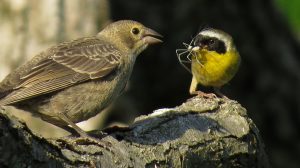
Brood parasitism has an evolutionary cost to the host since it reduces the survival rate of the host’s own offspring. To avoid parasitism, the host often ejects foreign eggs that have been laid in her nest (or destroys them). This requires the host to be able to discriminate between its eggs and the parasite’s eggs. In response, some parasites have evolved eggs that closely mimic the host’s eggs. Others have evolved eggs with thicker shells, which might be an adaptation to keep the hosts from puncturing the eggs.
Brood parasites have evolved a behavioral counter-adaptation to nest ejection. This is called mafia-like behavior. Parasites monitor the nests where they’ve laid their eggs. If the parasite’s egg has been rejected, the parasite will attack and destroy the nest of the host. In response, host species try to select nest sites that are difficult to parasitize, or aggressively defend their nesting areas against parasitic species.
Brood parasitism occurs in fish and insects as well. To learn more, you can read this article on Nature’s Scitable or this article on Wikipedia.
Finally, note that competition between species (interspecific competition) does not usually unleash an evolutionary arms race. That’s because of Gause’s competitive exclusion principle. The dynamic that occurs between competing species leads to differentiation. Once species have evolved enough character displacement for niche partitioning to occur, there’s no more selective pressure for continued differentiation. Another way to think of it is that the evolutionary dynamic involved in character displacement results in negative feedback. Because character displacement leads to less competition, differentiation winds up reducing evolutionary pressure, and the system turns itself off.
7. Species Interactions: Cumulative Quiz
The quiz below covers evolutionary arms races immediately above, but also everything else that’s been covered in this tutorial.
[qwiz style=”width: 700px !important; min-height: 400px !important;” qrecord_id=”sciencemusicvideosmeister1961-Evolutionary Arms Races and other species interactions”]
[h] Arms races and species interactions
[i]
[q labels = “top”]In an evolutionary ___________ race, _____________ in one species leads to a __________ adaptation in a second species, which feeds back to the first species. The result is a ___________ feedback loop.
[l]adaptations
[f*] Great!
[fx] No, that’s not correct. Please try again.
[l]counter
[f*] Great!
[fx] No. Please try again.
[l]arms
[f*] Good!
[fx] No. Please try again.
[l]positive
[f*] Correct!
[fx] No, that’s not correct. Please try again.
[q]Competition between members of the same species can unleash a(n) ______________ evolutionary arms race. This kind of evolutionary arms race explains, for example, how redwood trees got to be so tall. By contrast, the evolutionary dynamic of predator-prey or parasite-host interactions can unleash a(n) ________________ evolutionary arms race. In this type of arms race, an adaptation in a predator results in a ___________ counter-adaptation in the prey. This, in turn, creates evolutionary pressure that requires a counter-_____________ on the part of the predator, which feeds back to the _________.
[l]asymmetrical
[fx] No, that’s not correct. Please try again.
[f*] Good!
[l]defensive
[fx] No. Please try again.
[f*] Great!
[l]symmetrical
[fx] No, that’s not correct. Please try again.
[f*] Excellent!
[l]prey
[fx] No, that’s not correct. Please try again.
[f*] Correct!
[l]adaptation
[fx] No. Please try again.
[f*] Good!
[q] The sharp quills of porcupines and the spray of skunks are both examples of defensive adaptations that evolved in [hangman] for protection from [hangman].
[c]IHByZXk=[Qq]
[f]IEdvb2Qh[Qq]
[c]IHByZWRhdG9ycw==[Qq]
[f]IEdyZWF0IQ==[Qq]
[q] Because of competition, the [hangman] niche of a species is almost more narrow than its [hangman] niche.
[c]IHJlYWxpemVk[Qq]
[f]IEV4Y2VsbGVudCE=[Qq]
[c]IGZ1bmRhbWVudGFs[Qq]
[f]IEdyZWF0IQ==[Qq]
[q] The diagram below indicates that the width of species A’s niche was limited by [hangman] from species B. By contrast, species B was constrained by [hangman] factors such as temperature and air exposure
[c]IGNvbXBldGl0aW9u[Qq]
[f]IEV4Y2VsbGVudCE=[Qq]
[c]IGFiaW90aWM=[Qq]
[f]IEdyZWF0IQ==[Qq]
[q] In the diagram below, which letter indicates the fundamental niche of species A?
[textentry single_char=”true”]
[c]IE M=[Qq]
[f]IEV4YWN0bHkuICYjODIyMDtDJiM4MjIxOyBpcyB0aGUgZnVuZGFtZW50YWwgbmljaGUgb2Ygc3BlY2llcyBB[Qq]
[c]IEVudGVyIHdvcmQ=[Qq]
[f]IE5vLCB0aGF0JiM4MjE3O3Mgbm90IGNvcnJlY3Qu[Qq]
[c]ICo=[Qq]
[f]IE5vLiBIZXJlJiM4MjE3O3MgYSBoaW50LiBUaGUgZnVuZGFtZW50YWwgbmljaGUgb2YgYSBzcGVjaWVzIGlzIHRoZSByYW5nZSBvZiByZXNvdXJjZXMgaXQgY291bGQgZXhwbG9pdCBpbiB0aGUgYWJzZW5jZSBvZiBjb21wZXRpdGlvbi4gV2hhdCBsZXR0ZXIgc2hvd3MgaG93IEEgZG9lcyB3aGVuIGl0cyBjb21wZXRpdG9yIChCKSBpcyByZW1vdmVkPw==[Qq]
[q] The diagram below shows how [hangman] can lead to [hangman] [hangman].
[c]IGNvbXBldGl0aW9u[Qq]
[f]IEdvb2Qh[Qq]
[c]IGNoYXJhY3Rlcg==[Qq]
[f]IENvcnJlY3Qh[Qq]
[c]IGRpc3BsYWNlbWVudA==[Qq]
[f]IENvcnJlY3Qh[Qq]
[q] In the experiment shown below, both species can coexist because of niche [hangman].
[c]IHBhcnRpdGlvbmluZw==[Qq]
[f]IEV4Y2VsbGVudCE=[Qq]
[q] The idea that no two species can occupy the same niche at the same time in the same area is called the [hangman] [hangman] principle.
[c]IGNvbXBldGl0aXZl[Qq]
[f]IEV4Y2VsbGVudCE=[Qq]
[c]IGV4Y2x1c2lvbg==[Qq]
[f]IEdvb2Qh[Qq]
[q] Virus is to cell as [hangman] is to [hangman].
[c]IHBhcmFzaXRl[Qq]
[f]IEV4Y2VsbGVudCE=[Qq]
[c]IGhvc3Q=[Qq]
[f]IEdvb2Qh[Qq]
[q multiple_choice=”true”] Which interaction can induce evolutionary change, but of a type that results in more and more negative feedback?
[c]IHByZWRhdG9yLXByZXk=[Qq]
[f]IE5vLiBQcmVkYXRvci1wcmV5IGludGVyYWN0aW9ucyBvZnRlbiBpbmR1Y2UgZXZvbHV0aW9uYXJ5IGR5bmFtaWNzIHRoYXQgaW52b2x2ZSBwb3NpdGl2ZSBmZWVkYmFjaywgbGVhZGluZyB0byBzcGVjdGFjdWxhciBhZGFwdGF0aW9ucy4=[Qq]
[c]IHBhcmFzaXRlLWhvc3Q=[Qq]
[f]IE5vLiBQYXJhc2l0ZS1ob3N0IGludGVyYWN0aW9ucyBvZnRlbiBpbmR1Y2UgZXZvbHV0aW9uYXJ5IGR5bmFtaWNzIHRoYXQgaW52b2x2ZSBwb3NpdGl2ZSBmZWVkYmFjaywgbGVhZGluZyB0byBzcGVjdGFjdWxhciBhZGFwdGF0aW9ucy4=[Qq]
[c]IGludGVyc3BlY2lmaW MgY29tcGV0aXRpb24=[Qq]
[f]IE5pY2Ugam9iLiBJbnRlcnNwZWNpZmljIGNvbXBldGl0aW9uIGxlYWRzIHRvIGNoYXJhY3RlciBkaXNwbGFjZW1lbnQsIHdoaWNoIHJlZHVjZXMgdGhlIG5lZWQgZm9yIGZ1cnRoZXIgZXZvbHV0aW9uYXJ5IGNoYW5nZS4gSW4gb3RoZXIgd29yZHMsIHRoZSBzeXN0ZW0gZmVlZHMgYmFjayBvbiBpdHNlbGYgaW4gYSB3YXkgdGhhdCB0dXJucyB0aGUgc3lzdGVtIG9mZiwgbWFraW5nIGl0IGEgbmVnYXRpdmUgZmVlZGJhY2sgc3lzdGVtLg==[Qq]
[c]IGludHJhc3BlY2lmaWMgY29tcGV0aXRpb24=[Qq]
[f]IE5vLiBJbnRyYXNwZWNpZmljIGNvbXBldGl0aW9uIGNhbiBpbmR1Y2UgZXZvbHV0aW9uYXJ5IGR5bmFtaWNzIHRoYXQgaW52b2x2ZSBwb3NpdGl2ZSBmZWVkYmFjaywgbGVhZGluZyB0byBzcGVjdGFjdWxhciBhZGFwdGF0aW9ucy4=[Qq]
[q] The way an organism makes its living is its [hangman]. The place where an organism makes its living is its [hangman].
[c]IG5pY2hl[Qq]
[f]IENvcnJlY3Qh[Qq]
[c]IGhhYml0YXQ=[Qq]
[f]IEdyZWF0IQ==[Qq]
[q] When two different species live in close association, it’s called a [hangman].
[c]IHN5bWJpb3Npcw==[Qq]
[f]IEV4Y2VsbGVudCE=[Qq]
[q multiple_choice=”true”] In the Star Wars universe, midi-chlorians are microscopic life forms that live within all living cells, providing life with the (fictional) Force. This sounds like which kind of interaction?
[c]IHBhcmFzaXRlLWhvc3Q=[Qq]
[f]IE5vLiBUaGUgbWlkaS1jaGxvcmlhbnMgc2VlbSBiZW5lZmljaWFsLg==[Qq]
[c]IGVuZG9zeW1iaW90 aWMgbXV0dWFsaXNt[Qq]
[f]IFllcy4gSXQgc2VlbXMgbGlrZSBhIHdpbi13aW4gcmVsYXRpb25zaGlwIChtdXR1YWxpc20pLCBhbmQgb25lIG9yZ2FuaXNtIGxpdmVzIGluc2lkZSBhbm90aGVyIChlbmRvc3ltYmlvc2lzKS4=[Qq]
[c]IGNvbW1lbnNhbGlzbQ==[Qq]
[f]IE5vLiBJbiBhIGNvbW1lbnNhbCByZWxhdGlvbnNoaXAsIG9uZSBvcmdhbmlzbSBiZW5lZml0cywgYW5kIHRoZSBvdGhlciBpcyB1bmFmZmVjdGVkLiBUaGlzIHNlZW1zIGxpa2UgYSByZWxhdGlvbnNoaXAgaW4gd2hpY2ggYm90aCBiZW5lZml0Lg==[Qq]
[c]IHByZWRhdG9yLXByZXk=[Qq]
[f]IFByZWRhdG9ycyBraWxsIGFuZCBlYXQgdGhlaXIgcHJleS4gVGhhdCBkb2VzbiYjODIxNzt0IHNlZW0gdG8gYmUgZ29pbmcgb24gaGVyZS4=
Cg==W3Jlc3RhcnRd[Qq]
[/qwiz]
Links
- Community Ecology 2: Keystone Species and Trophic Cascades (the next tutorial in this module)
- Community Ecology Main Menu

